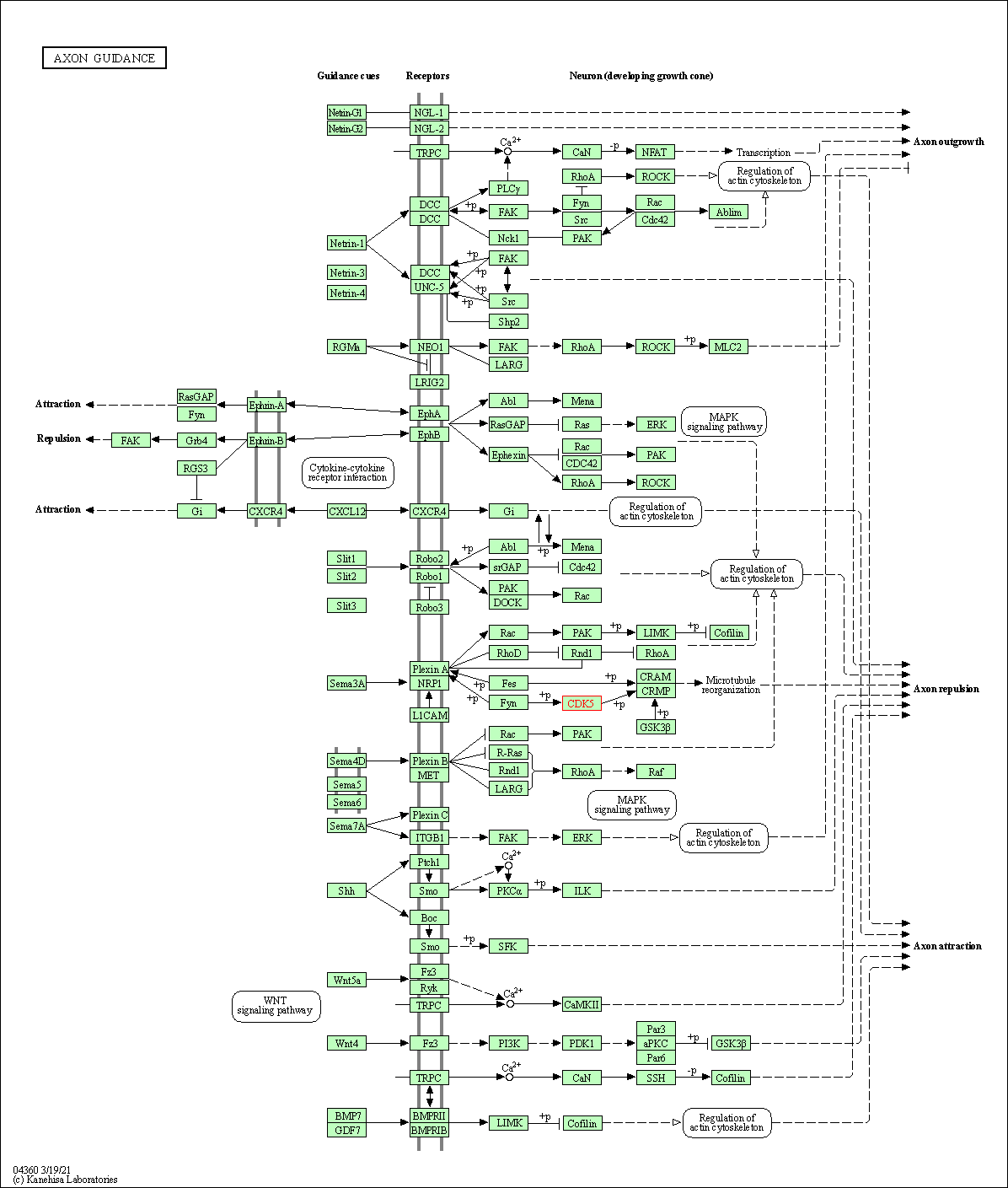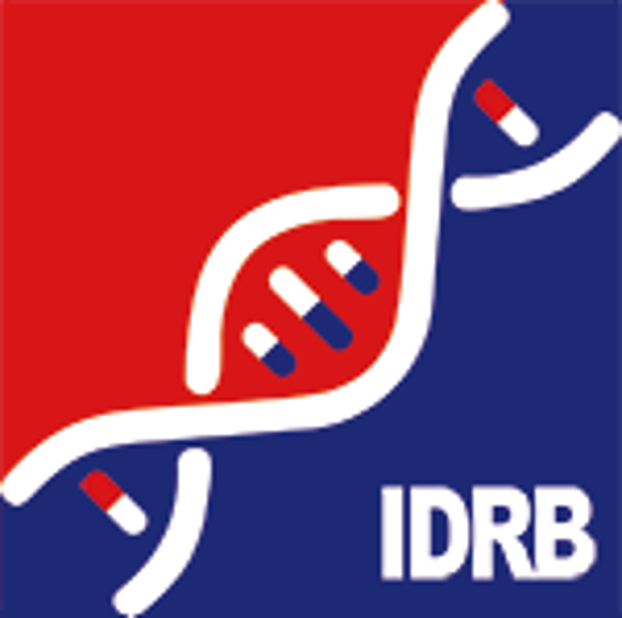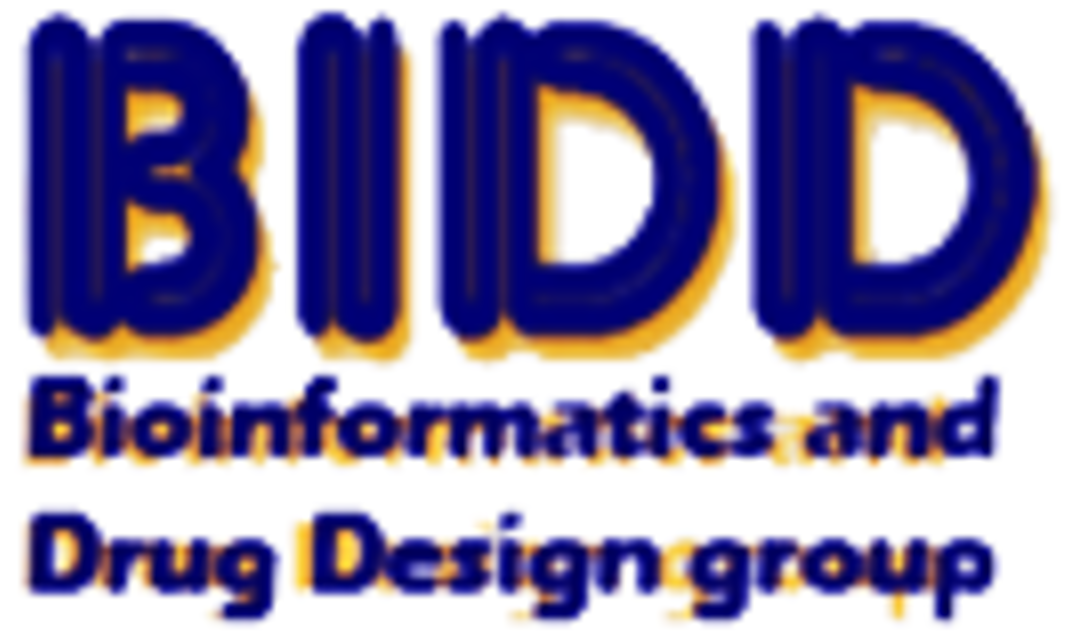Target Information
| Target General Information | Top | |||||
|---|---|---|---|---|---|---|
| Target ID |
T20973
(Former ID: TTDR00296)
|
|||||
| Target Name |
Cyclin-dependent kinase 5 (CDK5)
|
|||||
| Synonyms |
Tau protein kinase II catalytic subunit; TPKII catalytic subunit; Serine/threonine-protein kinase PSSALRE; Serine/threonine protein kinase PSSALRE; Proline-directed protein kinase F(A) (PDPK F(A)); Proline-directed protein kinase 33 kDa subunit; PDPK; Cyclin-dependent-like kinase 5; Cyclin-dependent kinase 5 (CDK5); Cell division protein kinase 5; CDKN5
Click to Show/Hide
|
|||||
| Gene Name |
CDK5
|
|||||
| Target Type |
Patented-recorded target
|
[1] | ||||
| Disease | [+] 1 Target-related Diseases | + | ||||
| 1 | Obesity [ICD-11: 5B80-5B81] | |||||
| Function |
Interacts with D1 and D3-type G1 cyclins. Phosphorylates SRC, NOS3, VIM/vimentin, p35/CDK5R1, MEF2A, SIPA1L1, SH3GLB1, PXN, PAK1, MCAM/MUC18, SEPT5, SYN1, DNM1, AMPH, SYNJ1, CDK16, RAC1, RHOA, CDC42, TONEBP/NFAT5, MAPT/TAU, MAP1B, histone H1, p53/TP53, HDAC1, APEX1, PTK2/FAK1, huntingtin/HTT, ATM, MAP2, NEFH and NEFM. Regulates several neuronal development and physiological processes including neuronal survival, migration and differentiation, axonal and neurite growth, synaptogenesis, oligodendrocyte differentiation, synaptic plasticity and neurotransmission, by phosphorylating key proteins. Activated by interaction with CDK5R1 (p35) and CDK5R2 (p39), especially in post-mitotic neurons, and promotes CDK5R1 (p35) expression in an autostimulation loop. Phosphorylates many downstream substrates such as Rho and Ras family small GTPases (e. g. PAK1, RAC1, RHOA, CDC42) or microtubule-binding proteins (e. g. MAPT/TAU, MAP2, MAP1B), and modulates actin dynamics to regulate neurite growth and/or spine morphogenesis. Phosphorylates also exocytosis associated proteins such as MCAM/MUC18, SEPT5, SYN1, and CDK16/PCTAIRE1 as well as endocytosis associated proteins such as DNM1, AMPH and SYNJ1 at synaptic terminals. In the mature central nervous system (CNS), regulates neurotransmitter movements by phosphorylating substrates associated with neurotransmitter release and synapse plasticity; synaptic vesicle exocytosis, vesicles fusion with the presynaptic membrane, and endocytosis. Promotes cell survival by activating anti-apoptotic proteins BCL2 and STAT3, and negatively regulating of JNK3/MAPK10 activity. Phosphorylation of p53/TP53 in response to genotoxic and oxidative stresses enhances its stabilization by preventing ubiquitin ligase-mediated proteasomal degradation, and induces transactivation of p53/TP53 target genes, thus regulating apoptosis. Phosphorylation of p35/CDK5R1 enhances its stabilization by preventing calpain-mediated proteolysis producing p25/CDK5R1 and avoiding ubiquitin ligase-mediated proteasomal degradation. During aberrant cell-cycle activity and DNA damage, p25/CDK5 activity elicits cell-cycle activity and double-strand DNA breaks that precedes neuronal death by deregulating HDAC1. DNA damage triggered phosphorylation of huntingtin/HTT in nuclei of neurons protects neurons against polyglutamine expansion as well as DNA damage mediated toxicity. Phosphorylation of PXN reduces its interaction with PTK2/FAK1 in matrix-cell focal adhesions (MCFA) during oligodendrocytes (OLs) differentiation. Negative regulator of Wnt/beta-catenin signaling pathway. Activator of the GAIT (IFN-gamma-activated inhibitor of translation) pathway, which suppresses expression of a post-transcriptional regulon of proinflammatory genes in myeloid cells; phosphorylates the linker domain of glutamyl-prolyl tRNA synthetase (EPRS) in a IFN-gamma-dependent manner, the initial event in assembly of the GAIT complex. Phosphorylation of SH3GLB1 is required for autophagy induction in starved neurons. Phosphorylation of TONEBP/NFAT5 in response to osmotic stress mediates its rapid nuclear localization. MEF2 is inactivated by phosphorylation in nucleus in response to neurotoxin, thus leading to neuronal apoptosis. APEX1 AP-endodeoxyribonuclease is repressed by phosphorylation, resulting in accumulation of DNA damage and contributing to neuronal death. NOS3 phosphorylation down regulates NOS3-derived nitrite (NO) levels. SRC phosphorylation mediates its ubiquitin-dependent degradation and thus leads to cytoskeletal reorganization. May regulate endothelial cell migration and angiogenesis via the modulation of lamellipodia formation. Involved in dendritic spine morphogenesis by mediating the EFNA1-EPHA4 signaling. The complex p35/CDK5 participates in the regulation of the circadian clock by modulating the function of CLOCK protein: phosphorylates CLOCK at 'Thr-451' and 'Thr-461' and regulates the transcriptional activity of the CLOCK-ARNTL/BMAL1 heterodimer in association with altered stability and subcellular distribution. Proline-directed serine/threonine-protein kinase essential for neuronal cell cycle arrest and differentiation and may be involved in apoptotic cell death in neuronal diseases by triggering abortive cell cycle re-entry.
Click to Show/Hide
|
|||||
| BioChemical Class |
Kinase
|
|||||
| UniProt ID | ||||||
| EC Number |
EC 2.7.11.1
|
|||||
| Sequence |
MQKYEKLEKIGEGTYGTVFKAKNRETHEIVALKRVRLDDDDEGVPSSALREICLLKELKH
KNIVRLHDVLHSDKKLTLVFEFCDQDLKKYFDSCNGDLDPEIVKSFLFQLLKGLGFCHSR NVLHRDLKPQNLLINRNGELKLADFGLARAFGIPVRCYSAEVVTLWYRPPDVLFGAKLYS TSIDMWSAGCIFAELANAGRPLFPGNDVDDQLKRIFRLLGTPTEEQWPSMTKLPDYKPYP MYPATTSLVNVVPKLNATGRDLLQNLLKCNPVQRISAEEALQHPYFSDFCPP Click to Show/Hide
|
|||||
| 3D Structure | Click to Show 3D Structure of This Target | PDB | ||||
| HIT2.0 ID | T20VPX | |||||
| Drugs and Modes of Action | Top | |||||
|---|---|---|---|---|---|---|
| Preclinical Drug(s) | [+] 1 Preclinical Drugs | + | ||||
| 1 | L-751250 | Drug Info | Preclinical | Obesity | [2] | |
| Mode of Action | [+] 1 Modes of Action | + | ||||
| Inhibitor | [+] 26 Inhibitor drugs | + | ||||
| 1 | 4-(thiazol-5-yl)-pyrimidine derivative 2 | Drug Info | [3] | |||
| 2 | Flavonoid derivative 7 | Drug Info | [3] | |||
| 3 | KENPAULLONE | Drug Info | [1] | |||
| 4 | Naphthyridine and isoquinoline derivative 1 | Drug Info | [3] | |||
| 5 | PMID26161698-Compound-18 | Drug Info | [3] | |||
| 6 | Pyrazolo[1,5-a]-1,3,5-triazine derivative 1 | Drug Info | [3] | |||
| 7 | Roscovitine derivative 1 | Drug Info | [3] | |||
| 8 | Tricyclic benzimidazole derivative 1 | Drug Info | [3] | |||
| 9 | L-751250 | Drug Info | [4] | |||
| 10 | Olomoucine | Drug Info | [4] | |||
| 11 | 1-phenyl-3-(2-(pyridin-4-yl)thiazol-4-yl)urea | Drug Info | [5] | |||
| 12 | 10Z-Hymenialdisine | Drug Info | [4] | |||
| 13 | 3-(2-phenylthiazol-4-yl)quinolin-2(1H)-one | Drug Info | [6] | |||
| 14 | 9-Nitropaullone | Drug Info | [4] | |||
| 15 | aloisine A | Drug Info | [7], [8] | |||
| 16 | aminopurvalanol A | Drug Info | [9] | |||
| 17 | AZAKENPAULLONE | Drug Info | [1] | |||
| 18 | Indirubin-3'-monoxime | Drug Info | [4] | |||
| 19 | Indirubin-5-sulfonate | Drug Info | [4] | |||
| 20 | MANZAMINE A | Drug Info | [10] | |||
| 21 | NU6140 | Drug Info | [11] | |||
| 22 | Oxindole 16 (compound 3) | Drug Info | [4] | |||
| 23 | Oxindole 95 | Drug Info | [4] | |||
| 24 | Quinoxaline1 | Drug Info | [9] | |||
| 25 | SU9516 | Drug Info | [4] | |||
| 26 | Thieno analogue of kenpaullone | Drug Info | [1] | |||
| Cell-based Target Expression Variations | Top | |||||
|---|---|---|---|---|---|---|
| Cell-based Target Expression Variations | ||||||
| Drug Binding Sites of Target | Top | |||||
|---|---|---|---|---|---|---|
| Ligand Name: R-roscovitine | Ligand Info | |||||
| Structure Description | Structural mechanism for the inhibition of CD5-p25 from the roscovitine, aloisine and indirubin. | PDB:1UNL | ||||
| Method | X-ray diffraction | Resolution | 2.20 Å | Mutation | Yes | [12] |
| PDB Sequence |
MQKYEKLEKI
10 GEGTYGTVFK20 AKNRETHEIV30 ALKRVRLDDD40 DEGVPSSALR50 EICLLKELKH 60 KNIVRLHDVL70 HSDKKLTLVF80 EFCDQDLKKY90 FDSCNGDLDP100 EIVKSFLFQL 110 LKGLGFCHSR120 NVLHRDLKPQ130 NLLINRNGEL140 KLANFGLARA150 FGIPVRCYSA 160 EVVTLWYRPP170 DVLFGAKLYS180 TSIDMWSAGC190 IFAELANAGR200 PLFPGNDVDD 210 QLKRIFRLLG220 TPTEEQWPSM230 TKLPDYKPYP240 MYPATTSLVN250 VVPKLNATGR 260 DLLQNLLKCN270 PVQRISAEEA280 LQHPYFSDFC290 PP
|
|||||
|
|
||||||
| Ligand Name: Aloisine A | Ligand Info | |||||
| Structure Description | Structural mechanism for the inhibition of CDK5-p25 by roscovitine, aloisine and indirubin. | PDB:1UNG | ||||
| Method | X-ray diffraction | Resolution | 2.30 Å | Mutation | Yes | [12] |
| PDB Sequence |
MQKYEKLEKI
10 YGTVFKAKNR24 ETHEIVALKR34 VRLDDDDEGV44 PSSALREICL54 LKELKHKNIV 64 RLHDVLHSDK74 KLTLVFEFCD84 QDLKKYFDSC94 NGDLDPEIVK104 SFLFQLLKGL 114 GFCHSRNVLH124 RDLKPQNLLI134 NRNGELKLAN144 FGLARAFGIP154 VRCYSAEVVT 164 LWYRPPDVLF174 GAKLYSTSID184 MWSAGCIFAE194 LANAGRPLFP204 GNDVDDQLKR 214 IFRLLGTPTE224 EQWPSMTKLP234 DYKPYPMYPA244 TTSLVNVVPK254 LNATGRDLLQ 264 NLLKCNPVQR274 ISAEEALQHP284 YFSDFCPP
|
|||||
|
|
||||||
| Click to View More Binding Site Information of This Target with Different Ligands | ||||||
| Different Human System Profiles of Target | Top |
|---|---|
|
Human Similarity Proteins
of target is determined by comparing the sequence similarity of all human proteins with the target based on BLAST. The similarity proteins for a target are defined as the proteins with E-value < 0.005 and outside the protein families of the target.
A target that has fewer human similarity proteins outside its family is commonly regarded to possess a greater capacity to avoid undesired interactions and thus increase the possibility of finding successful drugs
(Brief Bioinform, 21: 649-662, 2020).
Human Tissue Distribution
of target is determined from a proteomics study that quantified more than 12,000 genes across 32 normal human tissues. Tissue Specificity (TS) score was used to define the enrichment of target across tissues.
The distribution of targets among different tissues or organs need to be taken into consideration when assessing the target druggability, as it is generally accepted that the wider the target distribution, the greater the concern over potential adverse effects
(Nat Rev Drug Discov, 20: 64-81, 2021).
Human Pathway Affiliation
of target is determined by the life-essential pathways provided on KEGG database. The target-affiliated pathways were defined based on the following two criteria (a) the pathways of the studied target should be life-essential for both healthy individuals and patients, and (b) the studied target should occupy an upstream position in the pathways and therefore had the ability to regulate biological function.
Targets involved in a fewer pathways have greater likelihood to be successfully developed, while those associated with more human pathways increase the chance of undesirable interferences with other human processes
(Pharmacol Rev, 58: 259-279, 2006).
Biological Network Descriptors
of target is determined based on a human protein-protein interactions (PPI) network consisting of 9,309 proteins and 52,713 PPIs, which were with a high confidence score of ≥ 0.95 collected from STRING database.
The network properties of targets based on protein-protein interactions (PPIs) have been widely adopted for the assessment of target’s druggability. Proteins with high node degree tend to have a high impact on network function through multiple interactions, while proteins with high betweenness centrality are regarded to be central for communication in interaction networks and regulate the flow of signaling information
(Front Pharmacol, 9, 1245, 2018;
Curr Opin Struct Biol. 44:134-142, 2017).
Human Similarity Proteins
Human Tissue Distribution
Human Pathway Affiliation
Biological Network Descriptors
|
|
|
Note:
If a protein has TS (tissue specficity) scores at least in one tissue >= 2.5, this protein is called tissue-enriched (including tissue-enriched-but-not-specific and tissue-specific). In the plots, the vertical lines are at thresholds 2.5 and 4.
|

| KEGG Pathway | Pathway ID | Affiliated Target | Pathway Map |
|---|---|---|---|
| Axon guidance | hsa04360 | Affiliated Target |

|
| Class: Organismal Systems => Development and regeneration | Pathway Hierarchy | ||
| Degree | 21 | Degree centrality | 2.26E-03 | Betweenness centrality | 1.70E-03 |
|---|---|---|---|---|---|
| Closeness centrality | 2.48E-01 | Radiality | 1.43E+01 | Clustering coefficient | 8.10E-02 |
| Neighborhood connectivity | 4.03E+01 | Topological coefficient | 6.75E-02 | Eccentricity | 11 |
| Download | Click to Download the Full PPI Network of This Target | ||||
| Chemical Structure based Activity Landscape of Target | Top |
|---|---|
| Drug Property Profile of Target | Top | |
|---|---|---|
| (1) Molecular Weight (mw) based Drug Clustering | (2) Octanol/Water Partition Coefficient (xlogp) based Drug Clustering | |
|
|
||
| (3) Hydrogen Bond Donor Count (hbonddonor) based Drug Clustering | (4) Hydrogen Bond Acceptor Count (hbondacc) based Drug Clustering | |
|
|
||
| (5) Rotatable Bond Count (rotbonds) based Drug Clustering | (6) Topological Polar Surface Area (polararea) based Drug Clustering | |
|
|
||
| "RO5" indicates the cutoff set by lipinski's rule of five; "D123AB" colored in GREEN denotes the no violation of any cutoff in lipinski's rule of five; "D123AB" colored in PURPLE refers to the violation of only one cutoff in lipinski's rule of five; "D123AB" colored in BLACK represents the violation of more than one cutoffs in lipinski's rule of five | ||
| Target Poor or Non Binders | Top | |||||
|---|---|---|---|---|---|---|
| Target Poor or Non Binders | ||||||
| Target Regulators | Top | |||||
|---|---|---|---|---|---|---|
| Target-interacting Proteins | ||||||
| Target-Related Models and Studies | Top | |||||
|---|---|---|---|---|---|---|
| Target Validation | ||||||
| References | Top | |||||
|---|---|---|---|---|---|---|
| REF 1 | 1-Azakenpaullone is a selective inhibitor of glycogen synthase kinase-3 beta. Bioorg Med Chem Lett. 2004 Jan 19;14(2):413-6. | |||||
| REF 2 | Emerging drugs for obesity: linking novel biological mechanisms to pharmaceutical pipelines. Expert Opin Emerg Drugs. 2005 Aug;10(3):643-60. | |||||
| REF 3 | Cyclin-dependent kinase inhibitors for cancer therapy: a patent review (2009 - 2014).Expert Opin Ther Pat. 2015;25(9):953-70. | |||||
| REF 4 | Pharmacological inhibitors of cyclin-dependent kinases. Trends Pharmacol Sci. 2002 Sep;23(9):417-25. | |||||
| REF 5 | Structure-activity relationships of 3,4-dihydro-1H-quinazolin-2-one derivatives as potential CDK5 inhibitors. Bioorg Med Chem. 2007 Oct 15;15(20):6574-95. | |||||
| REF 6 | Design and synthesis of quinolin-2(1H)-one derivatives as potent CDK5 inhibitors. Bioorg Med Chem Lett. 2007 Oct 1;17(19):5384-9. | |||||
| REF 7 | Aloisines, a new family of CDK/GSK-3 inhibitors. SAR study, crystal structure in complex with CDK2, enzyme selectivity, and cellular effects. J Med Chem. 2003 Jan 16;46(2):222-36. | |||||
| REF 8 | The Protein Data Bank. Nucleic Acids Res. 2000 Jan 1;28(1):235-42. | |||||
| REF 9 | A systematic interaction map of validated kinase inhibitors with Ser/Thr kinases. Proc Natl Acad Sci U S A. 2007 Dec 18;104(51):20523-8. | |||||
| REF 10 | Glycogen synthase kinase-3 (GSK-3) inhibitory activity and structure-activity relationship (SAR) studies of the manzamine alkaloids. Potential for ... J Nat Prod. 2007 Sep;70(9):1397-405. | |||||
| REF 11 | Potentiation of paclitaxel-induced apoptosis by the novel cyclin-dependent kinase inhibitor NU6140: a possible role for survivin down-regulation. Mol Cancer Ther. 2005 Sep;4(9):1328-37. | |||||
| REF 12 | Mechanism of CDK5/p25 binding by CDK inhibitors. J Med Chem. 2005 Feb 10;48(3):671-9. | |||||
If You Find Any Error in Data or Bug in Web Service, Please Kindly Report It to Dr. Zhou and Dr. Zhang.

